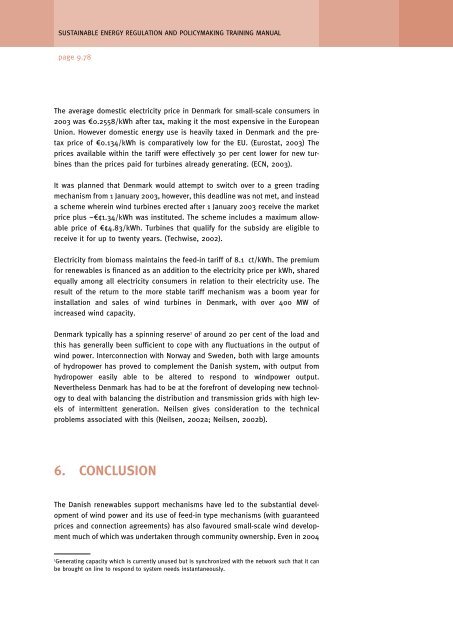Regulatory and policy options to encourage development of ...
Regulatory and policy options to encourage development of ...
Regulatory and policy options to encourage development of ...
- No tags were found...
You also want an ePaper? Increase the reach of your titles
YUMPU automatically turns print PDFs into web optimized ePapers that Google loves.
SUSTAINABLE ENERGY REGULATION AND POLICYMAKING TRAINING MANUALpage 9.78The average domestic electricity price in Denmark for small-scale consumers in2003 was €0.2558/kWh after tax, making it the most expensive in the EuropeanUnion. However domestic energy use is heavily taxed in Denmark <strong>and</strong> the pretaxprice <strong>of</strong> €0.134/kWh is comparatively low for the EU. (Eurostat, 2003) Theprices available within the tariff were effectively 30 per cent lower for new turbinesthan the prices paid for turbines already generating. (ECN, 2003).It was planned that Denmark would attempt <strong>to</strong> switch over <strong>to</strong> a green tradingmechanism from 1 January 2003, however, this deadline was not met, <strong>and</strong> insteada scheme wherein wind turbines erected after 1 January 2003 receive the marketprice plus ~€¢1.34/kWh was instituted. The scheme includes a maximum allowableprice <strong>of</strong> €¢4.83/kWh. Turbines that qualify for the subsidy are eligible <strong>to</strong>receive it for up <strong>to</strong> twenty years. (Techwise, 2002).Electricity from biomass maintains the feed-in tariff <strong>of</strong> 8.1 ct/kWh. The premiumfor renewables is financed as an addition <strong>to</strong> the electricity price per kWh, sharedequally among all electricity consumers in relation <strong>to</strong> their electricity use. Theresult <strong>of</strong> the return <strong>to</strong> the more stable tariff mechanism was a boom year forinstallation <strong>and</strong> sales <strong>of</strong> wind turbines in Denmark, with over 400 MW <strong>of</strong>increased wind capacity.Denmark typically has a spinning reserve 1 <strong>of</strong> around 20 per cent <strong>of</strong> the load <strong>and</strong>this has generally been sufficient <strong>to</strong> cope with any fluctuations in the output <strong>of</strong>wind power. Interconnection with Norway <strong>and</strong> Sweden, both with large amounts<strong>of</strong> hydropower has proved <strong>to</strong> complement the Danish system, with output fromhydropower easily able <strong>to</strong> be altered <strong>to</strong> respond <strong>to</strong> windpower output.Nevertheless Denmark has had <strong>to</strong> be at the forefront <strong>of</strong> developing new technology<strong>to</strong> deal with balancing the distribution <strong>and</strong> transmission grids with high levels<strong>of</strong> intermittent generation. Neilsen gives consideration <strong>to</strong> the technicalproblems associated with this (Neilsen, 2002a; Neilsen, 2002b).6. CONCLUSIONThe Danish renewables support mechanisms have led <strong>to</strong> the substantial developmen<strong>to</strong>f wind power <strong>and</strong> its use <strong>of</strong> feed-in type mechanisms (with guaranteedprices <strong>and</strong> connection agreements) has also favoured small-scale wind <strong>development</strong>much <strong>of</strong> which was undertaken through community ownership. Even in 20041Generating capacity which is currently unused but is synchronized with the network such that it canbe brought on line <strong>to</strong> respond <strong>to</strong> system needs instantaneously.










